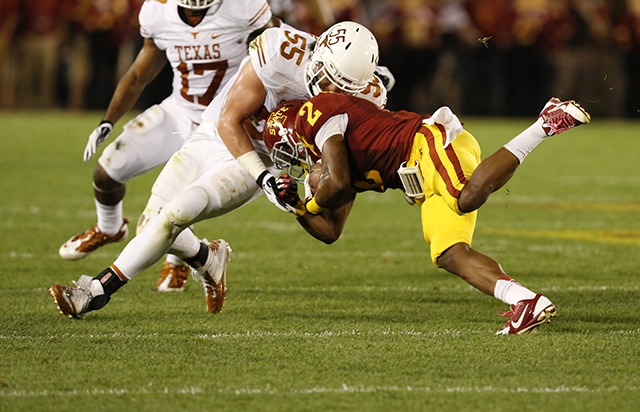You have /5 articles left.
Sign up for a free account or log in.

To prevent head trauma, football players are being told to avoid leading with the head.
Getty Images
WASHINGTON -- A new report on the prevalence, prevention and management of concussions in young athletes came to an important and not entirely surprising conclusion: There is a major and problematic shortage of research on the prevalence, prevention and management of concussions in young athletes.
And the report's authors, a committee convened by the Institute of Medicine of the National Academy of Sciences, want the National Collegiate Athletic Association to help change that. The NCAA should "undertake a rigorous scientific evaluation" of rules, techniques and standards in reducing concussions, and develop "large-scale efforts to increase knowledge about concussions and change the culture," the report says.
"If an athlete on the field tears their ligament, you immediately get them off the field," Robert Graham, a George Washington University research professor of health policy, said here at the report's release Wednesday. "Nobody expects you to just wrap it and put them back in. And yet that's what we do with a concussion."
Among the things doctors, trainers and coaches don't know: Why do concussion rates appear to be higher for female athletes and those at the high school level? What are the concussion triggers and thresholds of impact? Why do some people take longer than others to recover from a concussion? Does length of time between concussions affect further head trauma?
It will probably take years to answer those questions. But only then can colleges fully and effectively answer this one: How does one measure success in a concussion management program?
"We don't know how to do that," said Arthur C. Maerlender, an assistant professor of psychiatry at Dartmouth College. "Since we don't know what a concussion really is, it's hard to know what it isn't, and when recovery is.... It's a huge gap in the literature that needs to be addressed."
In a statement sent to Inside Higher Ed, Brian Hainline, the NCAA's chief medical officer, noted that he had not yet reviewed the report, but the NCAA is already doing some of what the report suggests.
"The NCAA is working with the National Federation of State High School Associations and other youth sport governing bodies across a broad spectrum in an effort to make health, safety, and an ethical value system within sports the basis of participation," Hainline said. "We welcome the opportunity to be a participant in this important discussion at all levels of youth sports."
The elusiveness of understanding head trauma is one reason the issue has proven difficult to address. Experts can recognize the symptoms, but how best to prevent and address sustained concussions remains largely a mystery. As a result, the research and activism landscape now is fragmented, with some conferences and universities taking action on their own.
The NCAA has been criticized for not doing more on the issue. It does require athletic programs to develop and maintain concussion management plans, which would stipulate things like baseline testing, removal from and return to play. But the NCAA does not enforce the plans or punish programs that don't adhere to them.
Last spring, the NCAA announced it would fund a $400,000 grant to the National Sport Concussion Outcomes Study, in which researchers from campuses including the Universities of Michigan and North Carolina at Chapel Hill will track athletes after they graduate and study the long-term effects of brain damage.
The National Collegiate Players Association, an athletes' advocacy group, says that's not enough. The NCPA wants the NCAA and athletic conferences to take more dramatic action, by limiting contact during practices and freezing the maximum number of regular-season games. In the past 15 years, that number has grown from 10 to 15, depending on whether a team qualifies for championships and bowl games.
NCPA persuaded the Pacific-12 Conference to become the second (behind the Ivy League) to limit contact in practices. The Pac-12 also will dedicate $3.5 million in new television revenue toward concussion research. But otherwise the organization's Concussion Awareness and Reduction Emergency Plan, which advocates for these ideas and others, has failed to gain traction.
Some officials have said they're resisting major changes until more research is available. For instance, the Southeastern Conference and the Big Ten Conference are both working on major head trauma research projects, but have declined to change standards or practices until they know whether it will be effective.
The report acknowledges that little is known about how much rules and playing standards impact the frequency and severity of head trauma -- which is why the authors call on the NCAA (in conjunction with similar groups at the K-12 sports level) to figure it out.
Bold action might be in the NCAA's favor, as it (along with a number of universities) faces a growing number of lawsuits alleging that it failed to prevent or address head trauma.
However, there is another problem that doesn't take a years-long study or half-million-dollar research grant to address, panelists said: the culture problem.
"There's still the sense that within many athletic cultures, there is the desire not to report," Graham said. Athletes don't want to let their teams down, coaches want to win, parents want to see their children perform. "This is the recommendation that can happen first -- with people saying, you know, that is an injury, we're going to treat it seriously."




